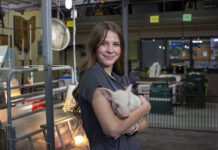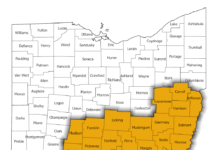SALEM, Ohio — Nearly four months have passed since the last case of highly pathogenic avian influenza was identified in the United States, but experts say that farmers and bird handlers need to keep up their guard as the fall migration season continues.
The last case was detected June 17, bringing the total of affected and depopulated birds to 7.5 million turkeys and 42.1 million layer and pullet chickens, across 21 states, since December 2014.
Being prepared
Ohio and Pennsylvania producers have managed to avoid any positive detections, but with the virus found as close as Indiana and Canada — eastern states need to keep up biosecurity and good sanitary practices.
Mohamed El-Gazzar, Ohio State University poultry Extension veterinarian, gave an update on what lies ahead, during the Ohio Farm Science Review, Sept. 22-24.
Related: USDA prepares for more avian influenza
First, producers and consumers should know that the virus has not shown to cross from poultry to humans — even in more populated countries, like those found in Asia. But El-Gazzar said producers should still exercise caution when handling birds, especially those known to be affected.
On the flip side, El-Gazzar said the virus is highly fatal for the birds, with about a 95 percent mortality rate — although in confirmed cases — all affected birds must be euthanized.
He said the virus still exists in the wild bird population, and as birds continue their southern migration, the risk for another outbreak is heightened.
“With the fall migration in a few weeks from now, there could be another wave of that outbreak,” he said.
Planning ahead
The downtime — since the last detection — has given experts within Ohio and at the federal level — more time to prepare.
The U.S. Department of Agriculture released its Fall Avian Influenza Preparedness and Response Plan mid-September, in which the agency highlighted the steps it’s taking to beef up protection of the U.S. flock, and how the states and nation will act in a “worst-case scenario.”
The plan includes a quicker depopulation time, with a goal of depopulating affected flocks within 24 hours. This was a farmer and USDA goal, because the faster sick birds are put down, the more likely the disease will be contained.
The plan also calls for a continuation of on-farm biosecurity practices — which help prevent contamination, an expansion of federal and state response when an outbreak is detected, improving communication, and improving the indemnity process, to pay producers who are forced to depopulate their birds.
Worst case
As part of its “worst scenario” planning, the USDA assumed 500 or more commercial establishments could be affected by the virus this fall, including backyard flocks, in the top 20 broiler, turkey and layer-producing states. Ohio and Pennsylvania are both included.
Ohio’s state veterinarian, Tony Forshey, said he’s been meeting on a weekly basis to discuss the state’s plan. His main advice is to follow the biosecurity guidelines, and make sure they are being implemented on large operations, and even in backyard flocks, as well as nature areas, like ponds and wildlife habitat.
“Watch your movement of anything,” he said, including the movement of people and cars, from one facility to another.
He said the summer heat was actually good for limiting the spread of the virus, but added that cold weather could help keep it alive.
“Man is always our biggest downfall when it comes to these diseases,” said Phillip Clauer, Penn State Extension poultry specialist.
“There’s always going to be somebody who isn’t going to do something right.”
Clauer said even small amounts of manure and contamination — the size of a dime — can be devastating to a flock of poultry.
He said Pennsylvania producers are “still holding our breath,” and being careful to continue following biosecurity practices.
According to Clauer, producers need to keep an eye on their flocks and report any issues as soon as possible. He worries that small-scale producers my try to depopulate and dispose of sick birds on their own — which if not done correctly — could cause the disease to spread.
According to USDA, all of the 20 top producing states have “made significant efforts in implementing detection, preparedness, and response capabilities for future (avian flu) cases.”
Vaccine option
The USDA is also in the process of preparing an acceptable vaccine for birds, closely matched to the current avian influenza strains. This could provide another tool to control future outbreaks, but as USDA notes, the decision to allow vaccines would require a close look at all consequences, including the potential loss of domestic and international sales.
El-Gazzar said the first goal is to contain the virus, and force it to die out. If that doesn’t work, birds could then be vaccinated. But he said vaccines could actually keep the virus around longer, because vaccinated birds would become immune to it.
Fair shows
A big question on the minds of 4-H and FFA exhibitors is whether they’ll be able to take poultry projects to the fair next year. Bans were issued in both Ohio and Pennsylvania, as a precautionary measure, to help control the spread of the virus.
El-Gazzar explained the decision, saying that the volume of birds brought to live shows, and then taken home, would have been “a disaster scenario for spreading the virus.”
Forshey said state officials will need to wait and see what happens this fall, before making a decision about next year. He said they should have a good idea by about the first of the year.
“The next 50 days will tell us a lot of things,” he said.
Clauer, likewise, said Pennsylvania producers are not yet out of the woods.
“If you look at history, typically we start seeing most of our outbreaks in November through December.”
Related coverage:










